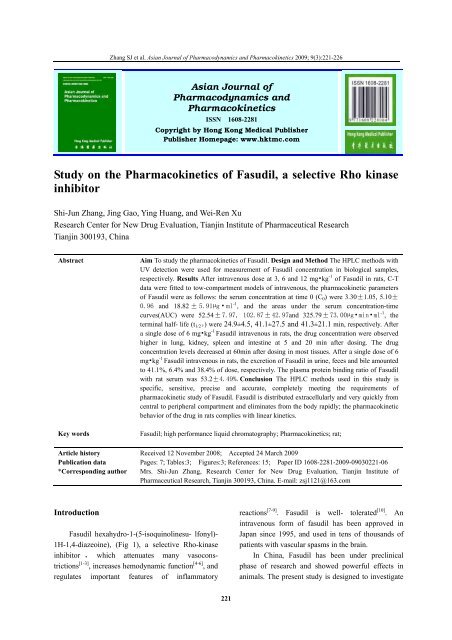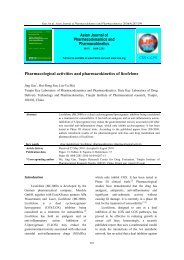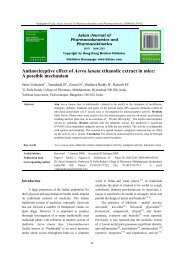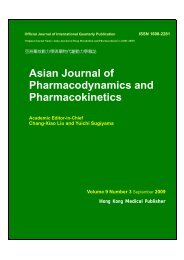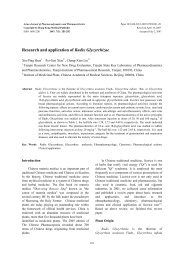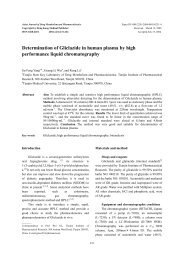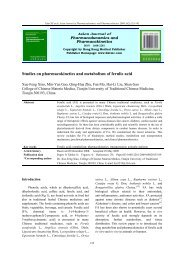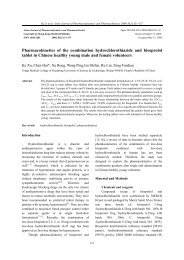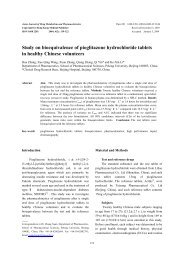Study on the Pharmacokinetics of Fasudil, a selective Rho kinase ...
Study on the Pharmacokinetics of Fasudil, a selective Rho kinase ...
Study on the Pharmacokinetics of Fasudil, a selective Rho kinase ...
You also want an ePaper? Increase the reach of your titles
YUMPU automatically turns print PDFs into web optimized ePapers that Google loves.
Zhang SJ et al. Asian Journal <strong>of</strong> Pharmacodynamics and <strong>Pharmacokinetics</strong> 2009; 9(3):221-226<br />
Asian Journal <strong>of</strong><br />
Pharmacodynamics and<br />
<strong>Pharmacokinetics</strong><br />
ISSN 1608-2281<br />
Copyright by H<strong>on</strong>g K<strong>on</strong>g Medical Publisher<br />
Publisher Homepage: www.hktmc.com<br />
<str<strong>on</strong>g>Study</str<strong>on</strong>g> <strong>on</strong> <strong>the</strong> <strong>Pharmacokinetics</strong> <strong>of</strong> <strong>Fasudil</strong>, a <strong>selective</strong> <strong>Rho</strong> <strong>kinase</strong><br />
inhibitor<br />
Shi-Jun Zhang, Jing Gao, Ying Huang, and Wei-Ren Xu<br />
Research Center for New Drug Evaluati<strong>on</strong>, Tianjin Institute <strong>of</strong> Pharmaceutical Research<br />
Tianjin 300193, China<br />
Abstract<br />
Key words<br />
Aim To study <strong>the</strong> pharmacokinetics <strong>of</strong> <strong>Fasudil</strong>. Design and Method The HPLC methods with<br />
UV detecti<strong>on</strong> were used for measurement <strong>of</strong> <strong>Fasudil</strong> c<strong>on</strong>centrati<strong>on</strong> in biological samples,<br />
respectively. Results After intravenous dose at 3, 6 and 12 mg•kg -1 <strong>of</strong> <strong>Fasudil</strong> in rats, C-T<br />
data were fitted to tow-compartment models <strong>of</strong> intravenous, <strong>the</strong> pharmacokinetic parameters<br />
<strong>of</strong> <strong>Fasudil</strong> were as follows: <strong>the</strong> serum c<strong>on</strong>centrati<strong>on</strong> at time 0 (C 0 ) were 3.301.05, 5.10<br />
and 18.82 µ • -1 , and <strong>the</strong> areas under <strong>the</strong> serum c<strong>on</strong>centrati<strong>on</strong>-time<br />
curves(AUC) were 52.54and 325.79µ•• -1 , <strong>the</strong><br />
terminal half- life (t 1/2 ) were 24.9±4.5, 41.1±27.5 and 41.3±21.1 min, respectively. After<br />
a single dose <strong>of</strong> 6 mg•kg -1 <strong>Fasudil</strong> intravenous in rats, <strong>the</strong> drug c<strong>on</strong>centrati<strong>on</strong> were observed<br />
higher in lung, kidney, spleen and intestine at 5 and 20 min after dosing. The drug<br />
c<strong>on</strong>centrati<strong>on</strong> levels decreased at 60min after dosing in most tissues. After a single dose <strong>of</strong> 6<br />
mg•kg -1 <strong>Fasudil</strong> intravenous in rats, <strong>the</strong> excreti<strong>on</strong> <strong>of</strong> <strong>Fasudil</strong> in urine, feces and bile amounted<br />
to 41.1%, 6.4% and 38.4% <strong>of</strong> dose, respectively. The plasma protein binding ratio <strong>of</strong> <strong>Fasudil</strong><br />
with rat serum was 53.2C<strong>on</strong>clusi<strong>on</strong> The HPLC methods used in this study is<br />
specific, sensitive, precise and accurate, completely meeting <strong>the</strong> requirements <strong>of</strong><br />
pharmacokinetic study <strong>of</strong> <strong>Fasudil</strong>. <strong>Fasudil</strong> is distributed extracellularly and very quickly from<br />
central to peripheral compartment and eliminates from <strong>the</strong> body rapidly; <strong>the</strong> pharmacokinetic<br />
behavior <strong>of</strong> <strong>the</strong> drug in rats complies with linear kinetics.<br />
<strong>Fasudil</strong>; high performance liquid chromatography; <strong>Pharmacokinetics</strong>; rat;<br />
Article history Received 12 November 2008; Accepted 24 March 2009<br />
Publicati<strong>on</strong> data Pages: 7; Tables:3; Figures:3; References: 15; Paper ID 1608-2281-2009-09030221-06<br />
*Corresp<strong>on</strong>ding author Mrs. Shi-Jun Zhang, Research Center for New Drug Evaluati<strong>on</strong>, Tianjin Institute <strong>of</strong><br />
Pharmaceutical Research, Tianjin 300193, China. E-mail: zsj1121@163.com<br />
Introducti<strong>on</strong><br />
<strong>Fasudil</strong> hexahydro-1-(5-isoquinolinesu- lf<strong>on</strong>yl)-<br />
1H-1,4-diazeoine), (Fig 1), a <strong>selective</strong> <strong>Rho</strong>-<strong>kinase</strong><br />
inhibitor which attenuates many vasoc<strong>on</strong>stricti<strong>on</strong>s<br />
[1-3] , increases hemodynamic functi<strong>on</strong> [4-6] , and<br />
regulates important features <strong>of</strong> inflammatory<br />
reacti<strong>on</strong>s [7-9] . <strong>Fasudil</strong> is well- tolerated [10] . An<br />
intravenous form <strong>of</strong> fasudil has been approved in<br />
Japan since 1995, and used in tens <strong>of</strong> thousands <strong>of</strong><br />
patients with vascular spasms in <strong>the</strong> brain.<br />
In China, <strong>Fasudil</strong> has been under preclinical<br />
phase <strong>of</strong> research and showed powerful effects in<br />
animals. The present study is designed to investigate<br />
221
Zhang SJ et al. Asian Journal <strong>of</strong> Pharmacodynamics and <strong>Pharmacokinetics</strong> 2009; 9(3):221-226<br />
<strong>the</strong> pharmacokinetic properties <strong>of</strong> <strong>Fasudil</strong> in rats in<br />
order to provide experiment basis for its development<br />
as a new drug.<br />
O<br />
O<br />
S<br />
N<br />
N<br />
NH ·HCl<br />
Fig 1. Chemical structure <strong>of</strong> <strong>Fasudil</strong><br />
Materials and methods<br />
Chemicals and reagents<br />
<strong>Fasudil</strong> was prepared by <strong>the</strong> chemical department<br />
<strong>of</strong> our institute, batch number: 970301. acet<strong>on</strong>itrile,<br />
HPLC grade, was produced by Tianjin Chemical<br />
Reagent Factory. O<strong>the</strong>r chemicals used were <strong>of</strong><br />
analytical grade. Distilled water, prepared from<br />
demineralized water, was used throughout <strong>the</strong> study.<br />
Animals<br />
Male Wistar rats (weighing 150~200g, Grade I,<br />
Certificate No 001) were produced by <strong>the</strong> animal<br />
department <strong>of</strong> our institute.<br />
Apparatus and analytical c<strong>on</strong>diti<strong>on</strong> for assay<br />
<strong>of</strong> <strong>Fasudil</strong><br />
The high performance liquid chromatographic<br />
(HPLC) analyses were used. It c<strong>on</strong>sisted <strong>of</strong> Waters<br />
510 pump, 710B injector, Shimadzu SPD-6A<br />
UV-visible detector and a ODS column<br />
(250mm×4.6mm I.D., 5µm Particle size). The mobile<br />
phase was water- acet<strong>on</strong>itrile- amm<strong>on</strong>ia (100:100:1,<br />
v/v) at flow rate <strong>of</strong> 1.0ml•min -1 . The UV detecti<strong>on</strong><br />
was at 215nm.<br />
Extracti<strong>on</strong> procedure for assay <strong>of</strong> <strong>Fasudil</strong><br />
Biological samples (serum, tissue homogenate,<br />
urine, feces or bile) 0.5mL and 0.5mL trichloroactic<br />
acid were mixed for 20 sec<strong>on</strong>ds and centrifuged at<br />
15000r•min -1 for 5min and 20µL <strong>of</strong> <strong>the</strong> upper layer<br />
were injected into <strong>the</strong> liquid chromatograph.<br />
Pharmacokinetic study<br />
According to <strong>the</strong> requisiti<strong>on</strong> <strong>on</strong> pharmacokinetic<br />
study design [11,12] , three doses <strong>of</strong> 3, 6 and 12mg•kg -1<br />
in rats were used for pharmacokinetic studies. The<br />
drug was dissolved with 9‰ sodium chloride<br />
soluti<strong>on</strong> for injecti<strong>on</strong>. The animals were fasted for<br />
15h and <strong>the</strong> blood samples were collected via eye<br />
vein at 0, 5, 10, 20, 40, 60 and 120min after<br />
intravenous in rats. After centrifugati<strong>on</strong>, <strong>the</strong> serum<br />
was used for determinati<strong>on</strong> <strong>of</strong> <strong>Fasudil</strong>.<br />
Distributi<strong>on</strong><br />
The brain, heart, lung, liver, kidney, spleen,<br />
stomach, intestinal, muscle, fat, testis and uterus<br />
were taken from rats and prepared for tissue<br />
homogenate at 5, 20 and 60min after intravenous <strong>of</strong><br />
6mg•kg -1 .<br />
Excreti<strong>on</strong><br />
Urine and feces excreti<strong>on</strong> 6 <strong>of</strong> male rats were<br />
placed into metabolic cages, respectively. The urine<br />
and feces were collected before injecti<strong>on</strong> and at 0~2,<br />
2~4, 4~8, 8~12, 12~24, 24~36, and 36~48h after<br />
dosing <strong>Fasudil</strong> <strong>of</strong> 6 mg•kg -1 . The drug c<strong>on</strong>tents in<br />
urine and feces (treated with water) were assayed<br />
with <strong>the</strong> designed methods, respectively.<br />
Bile excreti<strong>on</strong> Rats were anaes<strong>the</strong>tized with<br />
uratan and fixed <strong>on</strong> a stage. A bile fistula was<br />
performed from <strong>the</strong> comm<strong>on</strong> bile duct with a thin<br />
plastic tube to collect bile. The bile was collected<br />
before dosing and at 0~2, 2~6, 6~8, 8~12 and<br />
12~24h after injecti<strong>on</strong> <strong>Fasudil</strong> <strong>of</strong> 6 mg•kg -1 .<br />
Plasma protein binding<br />
Tree c<strong>on</strong>centrati<strong>on</strong> <strong>of</strong> <strong>Fasudil</strong> (2.5, 5 and<br />
10µg•mL -1 were used for <strong>the</strong> plasma protein binding<br />
test using a filtering method.<br />
Pharmacokinetic analysis<br />
Using <strong>the</strong> 3P97 Program (versi<strong>on</strong> 1997)<br />
developed by Ma<strong>the</strong>matical Pharmacological<br />
Committee, Chinese Pharmacological Society, <strong>the</strong><br />
compartment model <strong>of</strong> plasma c<strong>on</strong>centrati<strong>on</strong> – time<br />
curves was fitted and <strong>the</strong> pharmacokinetic parameters<br />
including K (first-order rate c<strong>on</strong>stant), t 1/2β (half-life),<br />
V d (apparent volume <strong>of</strong> distributi<strong>on</strong>), CL (total body<br />
clearance), AUC (area under drug plasma<br />
c<strong>on</strong>centrati<strong>on</strong>-time curve) were estimated.<br />
222
Zhang SJ et al. Asian Journal <strong>of</strong> Pharmacodynamics and <strong>Pharmacokinetics</strong> 2009; 9(3):221-226<br />
Statistical analysis<br />
Data are presented as arithmetic mean ±<br />
standard deviati<strong>on</strong> (SD).<br />
Results<br />
Analytical method validati<strong>on</strong><br />
According to <strong>the</strong> requisiti<strong>on</strong> for<br />
pharmacokinetic studies, <strong>the</strong> analytical method was<br />
validated. [13-15]<br />
Chromatographic behavior<br />
In <strong>the</strong> c<strong>on</strong>diti<strong>on</strong>s as described above, <strong>the</strong><br />
retenti<strong>on</strong> time <strong>of</strong> <strong>Fasudil</strong>e was about 5 min (Fig1).<br />
The endogenous substances in serum did not<br />
interfered separati<strong>on</strong>.<br />
A B C D<br />
Fig 2. Chromatograms <strong>of</strong> <strong>Fasudil</strong><br />
A. Standard c<strong>on</strong>taining <strong>Fasudil</strong> (F: <strong>Fasudil</strong>) B. Drug-free serum<br />
C. Serum spiked with <strong>Fasudil</strong> D. Serum 5min after intravenous <strong>of</strong> <strong>Fasudil</strong> 6mg•kg -1 in rat.<br />
Calibrati<strong>on</strong> curves<br />
The linearity was evaluated by c<strong>on</strong>structing a<br />
calibrati<strong>on</strong> curve in <strong>the</strong> various biological media. The<br />
linearity was tested by linear regressi<strong>on</strong> <strong>of</strong> <strong>the</strong> peak<br />
areas (Y) versus <strong>the</strong> c<strong>on</strong>centrati<strong>on</strong> <strong>of</strong> <strong>the</strong> drug (X).<br />
The calibrati<strong>on</strong> curve <strong>of</strong> <strong>Fasudil</strong> in rat serum<br />
(c<strong>on</strong>centrati<strong>on</strong> at <strong>the</strong> ranges <strong>of</strong> 0-10g•mL -1 )was<br />
Y=0.1862+0.00005634X (r=0.9996).<br />
The calibrati<strong>on</strong> curves <strong>of</strong> <strong>Fasudil</strong> in rat tissue<br />
homogenate were<br />
for heart Y=0.23+0.00008X (r=0.999),<br />
for liver Y=0.23+0.00009X (r=0.997),<br />
for kidney Y=-0.353+0.00008X (r=0.999),<br />
for brain Y=0.315+0.00008X (r=0.999),<br />
for muscle Y=0.194+0.00008X (r=0.999).<br />
The calibrati<strong>on</strong> curves <strong>of</strong> <strong>Fasudil</strong> in rat urine,<br />
feces and bile were<br />
for urine Y=0.489+0.0001X (r=0.999),<br />
for feces Y=1.219+0.0001X (r=0.994),<br />
for bile Y=0.31+0.001X (r=0.999).<br />
The limit <strong>of</strong> detecti<strong>on</strong> was 0.2g•mL -1 , <strong>the</strong><br />
recovery were 80.9%, 86.0% and 88.2%, <strong>the</strong> relative<br />
standard deviati<strong>on</strong> (RSD) were 2.8%, 3.3% and 3.6%<br />
for within-day assay and 6.7%, 5.3% and 5.2% for<br />
between-day at <strong>Fasudil</strong> c<strong>on</strong>centrati<strong>on</strong>s <strong>of</strong> 1, 2 and<br />
5g•mL -1 , respectively.<br />
Pharmacokinetic study<br />
The c<strong>on</strong>centrati<strong>on</strong>-time data <strong>of</strong> <strong>Fasudil</strong> after<br />
intravenous <strong>of</strong> three doses in rats were shown in<br />
Table 1 and Fig 2. The results indicated that <strong>the</strong><br />
plasma c<strong>on</strong>centrati<strong>on</strong> after intravenous administrati<strong>on</strong><br />
decayed biexp<strong>on</strong>entially with time with an extremely<br />
rapid initial phase and followed by a relatively slow<br />
eliminati<strong>on</strong> phase. The two-compartment model for<br />
<strong>Fasudil</strong> was fur<strong>the</strong>r c<strong>on</strong>firmed by Wss, r, R 2 , AIC and<br />
F test. The main pharmacokinetic parameters were<br />
shown in Table 2 after intravenous <strong>Fasudil</strong> in rats.<br />
There were good correlati<strong>on</strong> between C 0 , AUC and<br />
doses.<br />
Sensitivity, recovery and precisi<strong>on</strong><br />
223
Zhang SJ et al. Asian Journal <strong>of</strong> Pharmacodynamics and <strong>Pharmacokinetics</strong> 2009; 9(3):221-226<br />
Table 1. Comparis<strong>on</strong> <strong>of</strong> <strong>Fasudil</strong> serum c<strong>on</strong>centrati<strong>on</strong>s after intravenous <strong>of</strong> <strong>Fasudil</strong><br />
3, 6 and 12 mg•kg -1 in rats (n=5, meanSD)<br />
Time Serum c<strong>on</strong>centrati<strong>on</strong>(g•mL -1 )<br />
(min) 3 mg•kg -1 6 mg•kg -1 12 mg•kg -1<br />
0 <br />
5 <br />
10 <br />
20 <br />
40 <br />
60 <br />
120 <br />
<br />
<br />
<br />
<br />
<br />
<br />
<br />
<br />
<br />
<br />
<br />
<br />
Fig2. Mean serum c<strong>on</strong>centrati<strong>on</strong>-time curves <strong>of</strong> <strong>Fasudil</strong> after single intravenous<br />
doses <strong>of</strong> <strong>Fasudil</strong> 3, 6 and 12 mg•kg -1 in rats<br />
Table 2 The main pharmacokinetic parameters <strong>of</strong> <strong>Fasudil</strong> after intravenous <strong>Fasudil</strong><br />
3, 6 and 12mg•kg -1 in rats<br />
Parameters 3 mg•kg -1 6 mg•kg -1 12 mg•kg -1<br />
C 0 (g•mL -1 ) 3.30±1.05 5.10±0.96 18.82±5.91<br />
T 1/2 24.9±4.5 41.1±27.5 41.3±21.1<br />
V (C) (mL) 0.94±0.26 1.17±0.24 0.72±0.20<br />
CL (s) (mL•min) 0.052±0.009 0.061±0.027 0.037±0.008<br />
AUC (0~Tn) (g•min •mL -1 ) 52.5±8.0 102.9±43.0 325.8±73.0<br />
MRT (min) 15.8±2.6 23.5±9.8 26.3±6.0<br />
Tissue distributi<strong>on</strong><br />
The drug could be widely distributed into tissues<br />
after intravenous 6 mg•kg -1 in rats (Table 3). As<br />
shown in Fig 3, <strong>the</strong> c<strong>on</strong>centrati<strong>on</strong>s <strong>of</strong> <strong>Fasudil</strong> were<br />
observed in lung, kidney, spleen and intestine higher<br />
at 5 and 20min after dosing.<br />
Excreti<strong>on</strong><br />
Urine and feces excreti<strong>on</strong><br />
41.1%, 6.4% <strong>of</strong> administered dose were<br />
224
Zhang SJ et al. Asian Journal <strong>of</strong> Pharmacodynamics and <strong>Pharmacokinetics</strong> 2009; 9(3):221-226<br />
excreted The results in <strong>the</strong> urine and <strong>the</strong> feces<br />
indicated that <strong>Fasudil</strong> in <strong>the</strong> urine and could<br />
distribute widely and rapidly to tissues and excreted<br />
gradually from tissues.<br />
As shown in Fig 3, <strong>the</strong> c<strong>on</strong>centrati<strong>on</strong>s <strong>of</strong> <strong>Fasudil</strong><br />
eces during 0~48 h after intravenous dosing <strong>of</strong><br />
<strong>Fasudil</strong> 6 mg•kg -1 in rats. The results indicated that<br />
<strong>the</strong> drug was mainly excreted via urine.<br />
Bile excreti<strong>on</strong> 38.4% <strong>of</strong> administered dose was<br />
excreted in <strong>the</strong> bile during 0~24 h after intravenous<br />
dosing <strong>of</strong> <strong>Fasudil</strong> 6 mg•kg -1 in rats.<br />
in most tissues were higher at 5 and 20min, lower at<br />
60min after dosing. The results indicated that <strong>Fasudil</strong><br />
could distribute widely and rapidly to tissues and<br />
excreted gradually from tissues.<br />
Protein Binding<br />
At <strong>the</strong> c<strong>on</strong>centrati<strong>on</strong> <strong>of</strong> <strong>Fasudil</strong> 2.5, 5 and<br />
10µg•mL -1 , <strong>the</strong> plasma protein binding ratios were<br />
55.2±5.8%, 54.7±1.3% and 49.6±3.3%, respectively.<br />
Table 3 Tissue distributi<strong>on</strong> <strong>of</strong> <strong>Fasudil</strong><br />
Tissue<br />
Drug c<strong>on</strong>centrati<strong>on</strong>s (µg•g-1)<br />
5min 20min 60min<br />
Heart 2.80±1.80 4.16±2.42 2.00±1.61<br />
Liver 4.44±3.60 2.59±1.29 2.91±3.26<br />
Spleen 8.40±3.16 11.73±9.41 3.85±3.42<br />
Lung 18.92±11.72 10.93±13.33 2.62±2.14<br />
Kidney 12.56±11.84 9.91±3.10 5.68±5.80<br />
Brain 3.80±2.29 2.45±0.74 2.20±1.02<br />
Stomach 4.41±3.94 3.85±1.95 1.54±1.52<br />
Intestine 6.21±5.05 5.29±1.22 1.76±1.71<br />
Muscle 4.06±1.40 2.99±2.39 1.91±1.41<br />
Fat 2.49±0.94 2.09±1.05 1.61±0.53<br />
Uterus 1.17±0.81 2.10±0.87 0.60±0.00<br />
Testis 4.82±6.16 1.51±0.46 1.45±0.33<br />
Serum 3.22±1.01 1.39±0.45 0.46±0.32<br />
<br />
<br />
<br />
<br />
<br />
<br />
<br />
<br />
<br />
<br />
<br />
hear<br />
lung<br />
kidney<br />
brain<br />
fat<br />
testicle<br />
liver<br />
spleen<br />
uterus<br />
stomach<br />
intestine<br />
muscle<br />
<br />
<br />
Discussi<strong>on</strong> and C<strong>on</strong>clusi<strong>on</strong><br />
225
Zhang SJ et al. Asian Journal <strong>of</strong> Pharmacodynamics and <strong>Pharmacokinetics</strong> 2009; 9(3):221-226<br />
In this study pharmacokinetics in rats <strong>of</strong><br />
<strong>Fasudil</strong> was investigated. The results showed that <strong>the</strong><br />
assay method utilized by us is very sensitive, high<br />
specific, precise so as to completely meet <strong>the</strong><br />
requirements <strong>of</strong> <strong>Fasudil</strong> pharmacokinetic study [13-15] .<br />
The data shows that fasudil is distributed<br />
extracellularly and transferred very quickly from<br />
central to peripheral compartment and eliminates<br />
from <strong>the</strong> body rapidly; <strong>the</strong> pharmacokinetic behavior<br />
<strong>of</strong> <strong>the</strong> drug in rats complies with linear kinetics.<br />
References<br />
1. Li FH, Xia W, Li AW, Zhao CF. Inhibiti<strong>on</strong> <strong>of</strong> <strong>Rho</strong> <strong>kinase</strong><br />
attenuates high flow induced pulm<strong>on</strong>ary hypertensi<strong>on</strong> rats.<br />
Chinese Medical Journal 2007;120(1):22-29.<br />
2. Vincelette J, Pagila R, Kawai K, Ishii M, Horimizu Y.<br />
Verg<strong>on</strong>a R, Sullivan ME, Morser J, Dole WP. Inhibiti<strong>on</strong> <strong>of</strong><br />
<strong>Rho</strong> <strong>kinase</strong> by hydroxyfasudil prevents vasopressin-induced<br />
myocardial ischemia in D<strong>on</strong>ryu rats by attenuating cor<strong>on</strong>ary<br />
vasoc<strong>on</strong>stricti<strong>on</strong>. Pharmacology 2005; 75(3):145-151.<br />
3. Shimomura E, Shiraishi, M, Iwanaga T, Seto M, Sasaki Y,<br />
Ikeda M, Ito K. Inhibiti<strong>on</strong> <strong>of</strong> protein <strong>kinase</strong> inhibitor<br />
fasudil in rabbit aorta. Nauny-Schmiedeberg’s Archives <strong>of</strong><br />
Pharmacology 2004; 370(5): 414-422.<br />
4. Rikitake Y, Kim HH, Huang Z, Seto M, Yano K. Inhibiti<strong>on</strong><br />
<strong>of</strong> <strong>Rho</strong> <strong>kinase</strong> (ROCK) leads to increased cerebral blood<br />
flow and stroke protecti<strong>on</strong>. Stroke 2005; 36(10): 2251-2257.<br />
5. Shin-ichi S, Tatsuma U. Pharmacological pr<strong>of</strong>ile <strong>of</strong> hydroxy<br />
fasudil as a <strong>selective</strong> <strong>Rho</strong> <strong>kinase</strong> inhibitor <strong>on</strong> ischemic brain<br />
damage. Life science 2001; 69(12): 1441-1453.<br />
6. Shibuya M, Asano T, Sasaki Y. Antianginal effects <strong>of</strong><br />
hydroxyfasudil, a <strong>Rho</strong> <strong>kinase</strong> inhibitor, in a canine model <strong>of</strong><br />
effort angina. Brit J Pharmacol 2001; 134(8): 1724-1730.<br />
7. Slotta JE, Braun OO, Menger MD, Thorlacius H. <strong>Fasudil</strong>, a<br />
<strong>Rho</strong>-<strong>kinase</strong> inhibitor, inhibits leukocyte adhesi<strong>on</strong> in<br />
inflamed large blood vessels in vivo. Inflammati<strong>on</strong> Research<br />
2006; 55(9): 364-367<br />
8. Thorlacius K, Slotta JE, Laschke MW, Wang Y. Protective<br />
effect <strong>of</strong> fasudil, a <strong>Rho</strong>-<strong>kinase</strong> inhibitor, <strong>on</strong> chemokine<br />
expressi<strong>on</strong>, leukocyte recruitment, and hepatocellular<br />
apoptosis in septic liver injury. J Leuk Biol 2006; 79(5)<br />
923-931.<br />
9. Hara M, Takayasu M. Protein <strong>kinase</strong> inhibiti<strong>on</strong> by fasudil<br />
hydrochloride promotes neurological recovery after spinal<br />
cord injury in rats. J Neurosurger 2000; 93(1)sup1: 94-101.<br />
10. Hinderling PH, Karara AH, Tao B, Pawula M, Wilding I, Lu<br />
M. Systemic availability <strong>of</strong> <strong>the</strong> active metabolite<br />
hydroxy-fasudil after administrati<strong>on</strong> <strong>of</strong> fasudil to different<br />
sites <strong>of</strong> <strong>the</strong> human gastrointestinal tract. J Clin Pharmacol<br />
2007; 47(1):19-25.<br />
11. Liu CX, Liu DY. Introducti<strong>on</strong> to pharmacokinetics Beijing:<br />
China Academic Press. 1984; 5-6.<br />
12. Liu CX. Practice <strong>Pharmacokinetics</strong>. Beijing: China<br />
Pharmaceutical Press, 2003; 21-25.<br />
13. Xia JH. Validati<strong>on</strong> <strong>of</strong> analytical methods for<br />
pharmacokinetics, bioavailability and bioequivalence<br />
studies. Asian J Drug Metab Pharmacokinet 2001;1(2):<br />
95-100.<br />
14. Liu CX, Wei GL, Li QS. Current status <strong>of</strong> guidelines for<br />
bioeuivalenece studies in difference countries. Asian J Drug<br />
Metab Pharmacokinet 2001;1(3): 207-215.<br />
15. Liu CX, Wei GL, Li QS. Methodology study <strong>of</strong> validati<strong>on</strong><br />
for bioanalysis in studies <strong>on</strong> pharmacokinetics and<br />
bioavailability. Asian J Drug Metab Pharmacokinet 2001;<br />
1(4): 279-286.<br />
226


